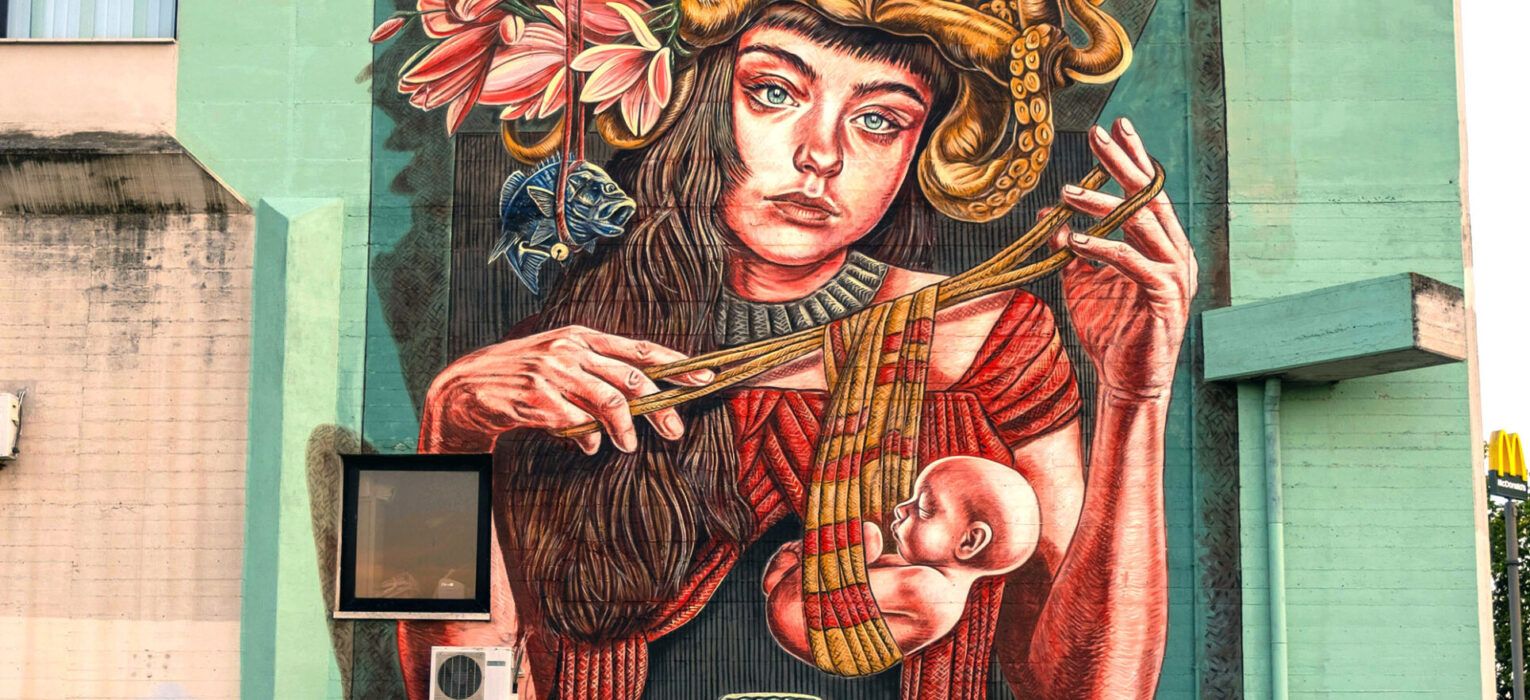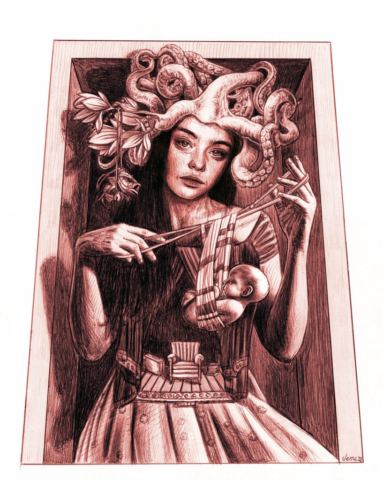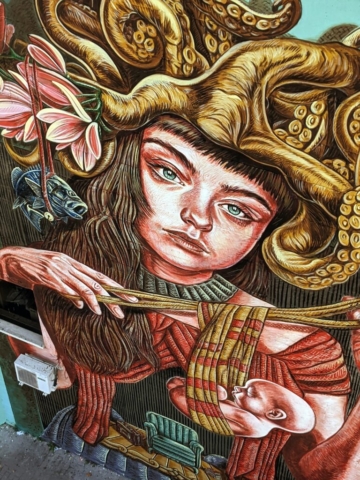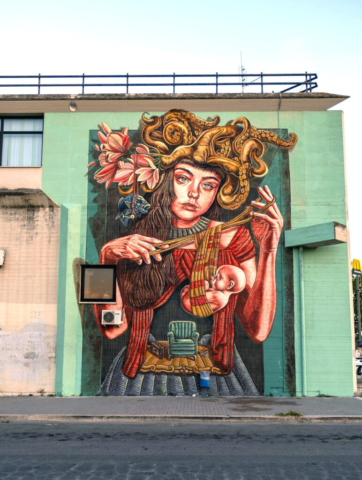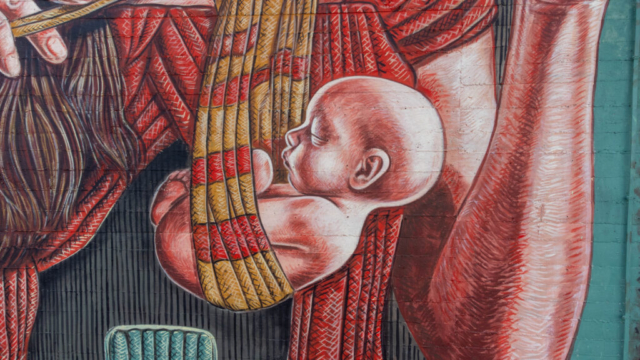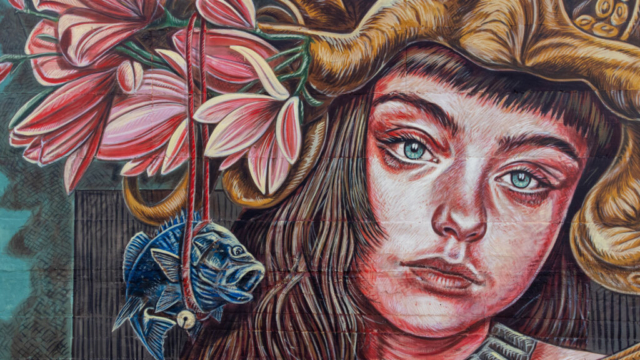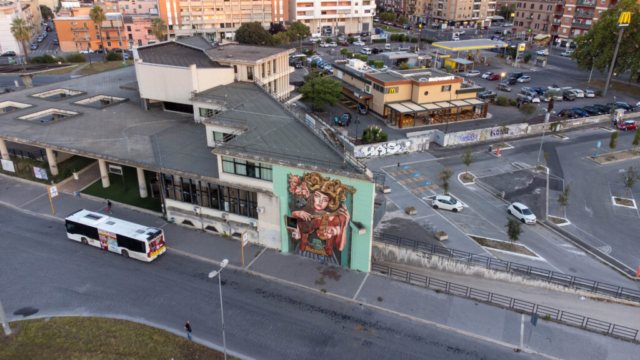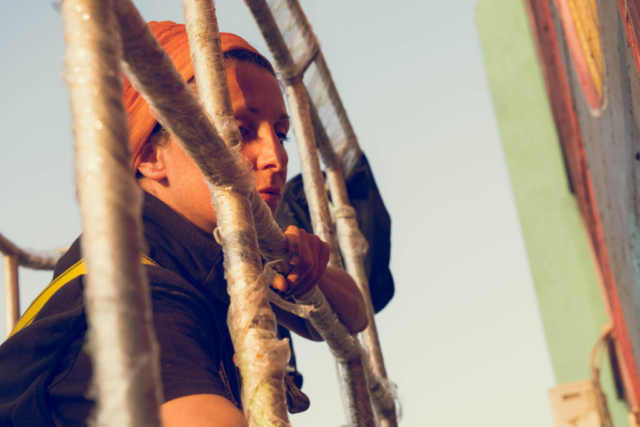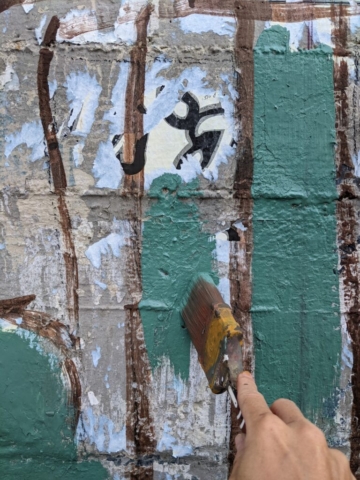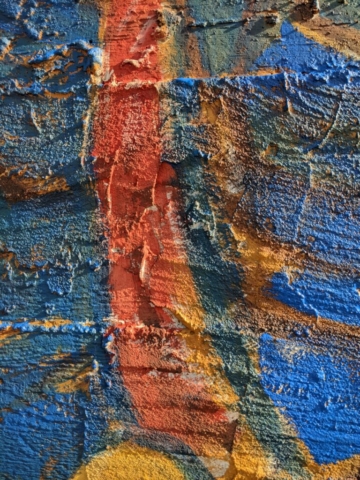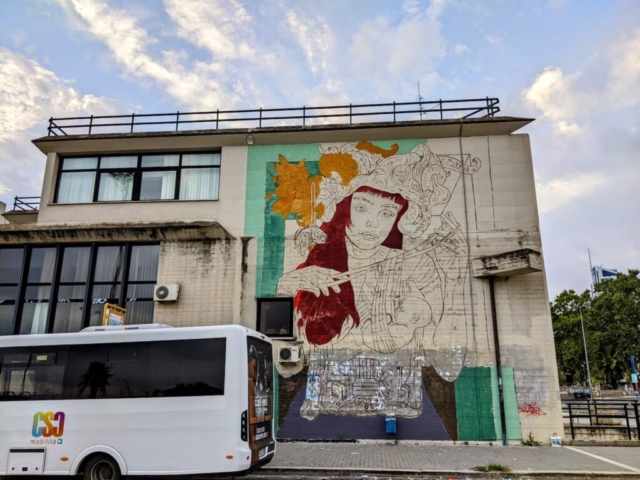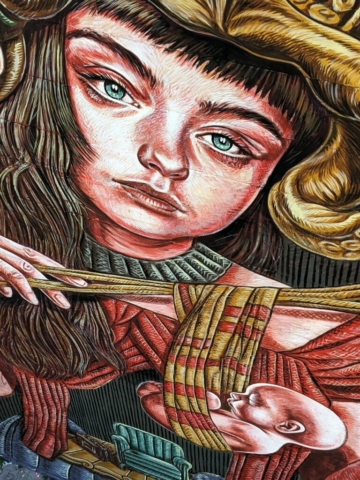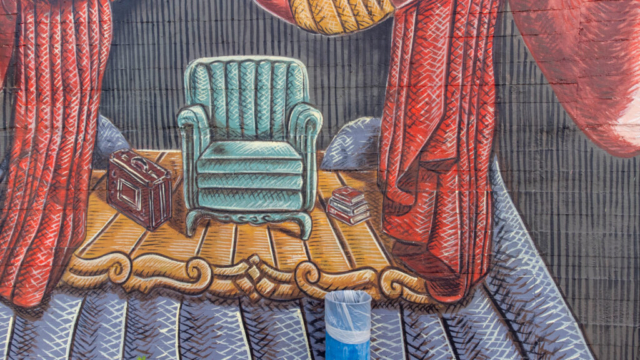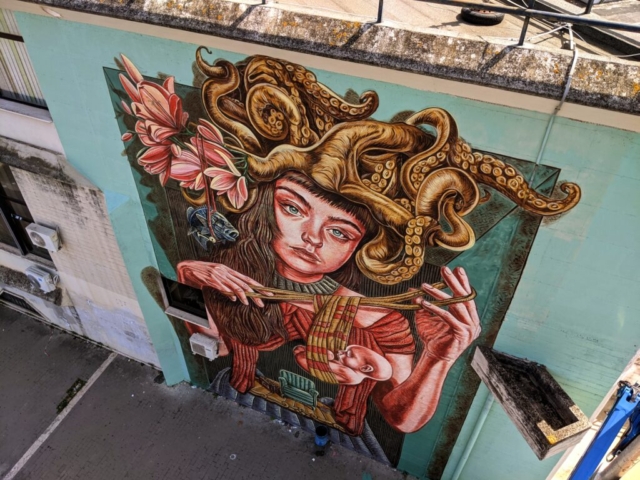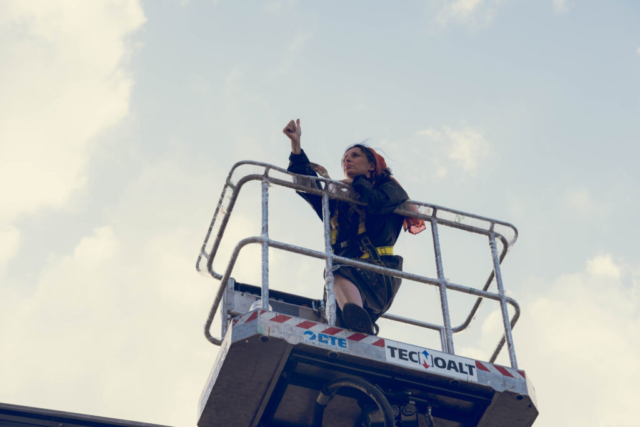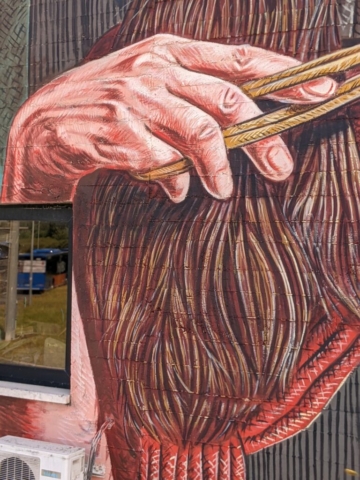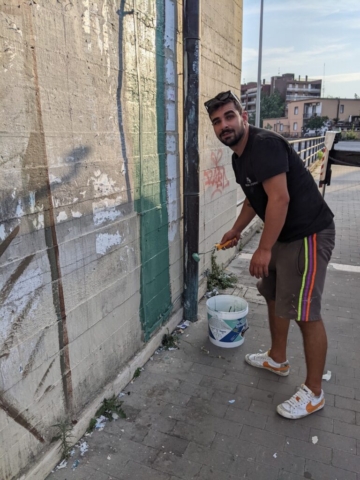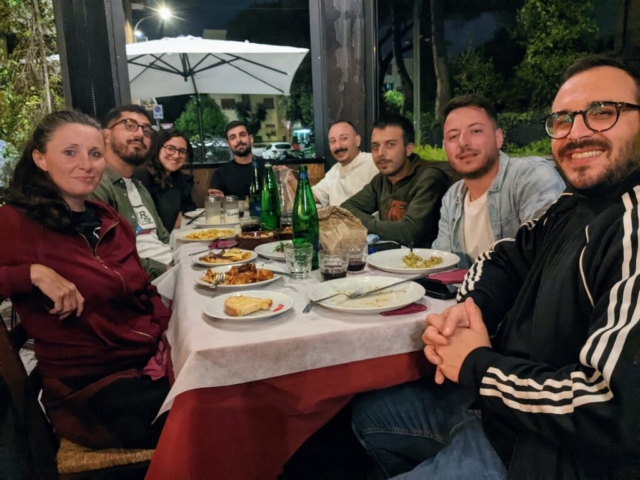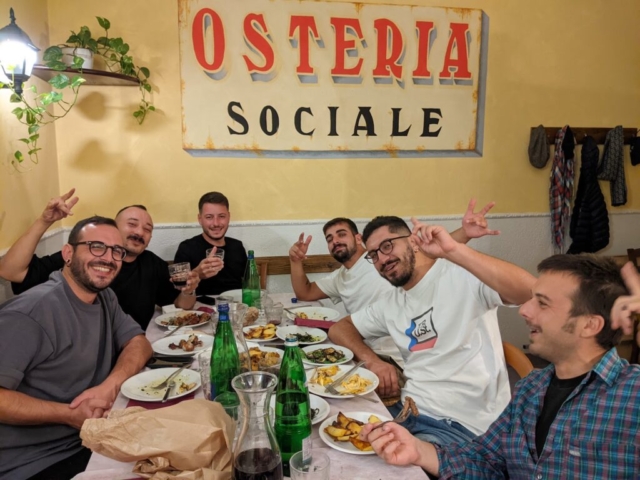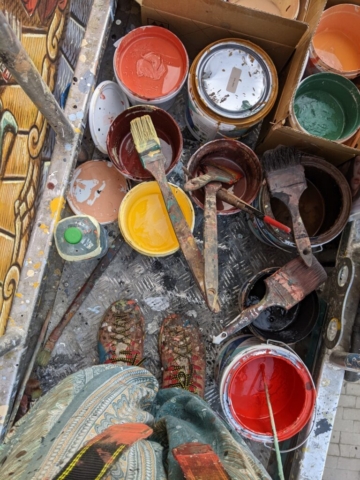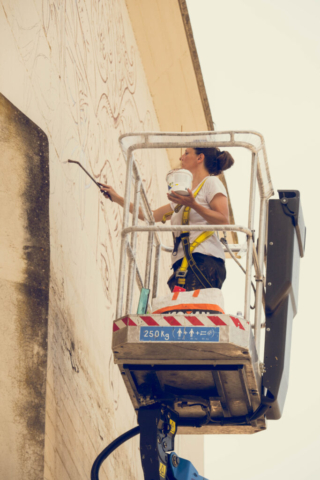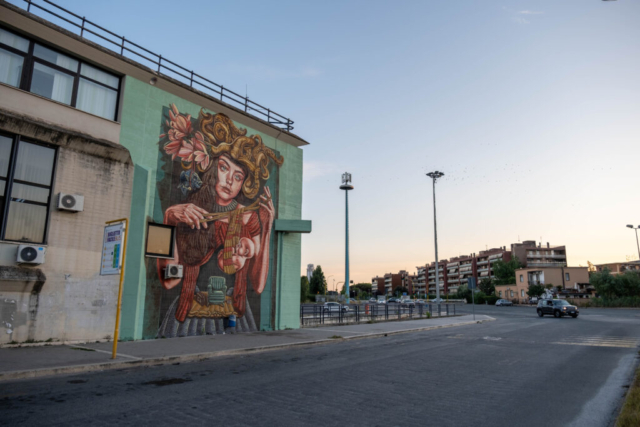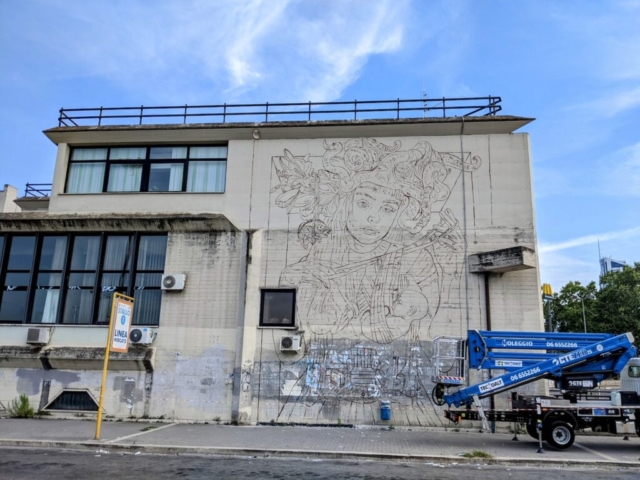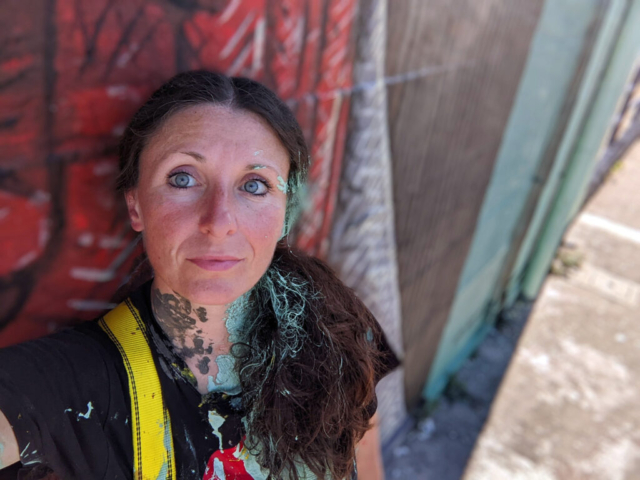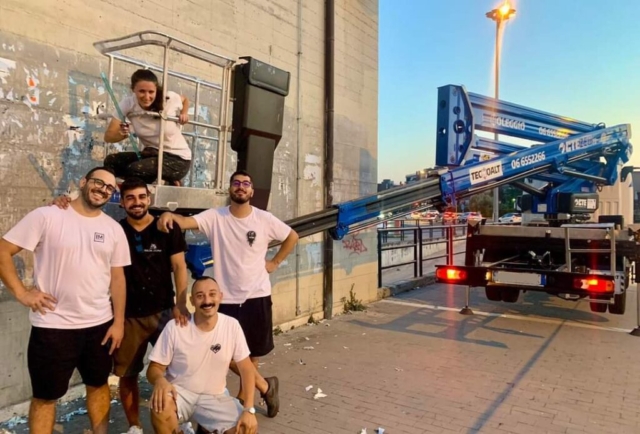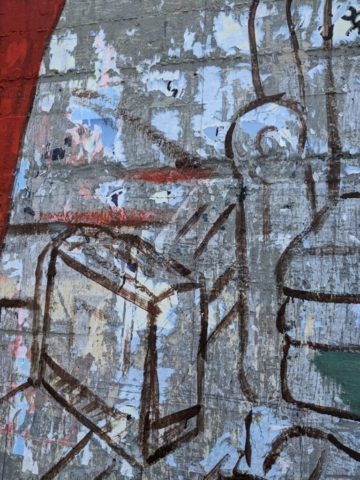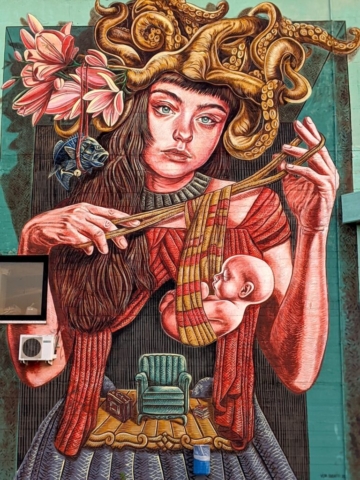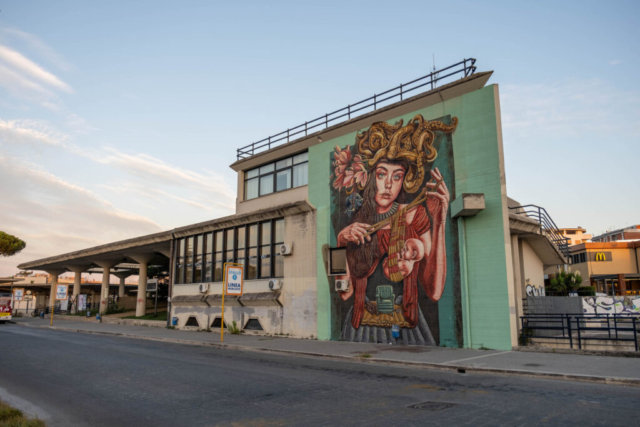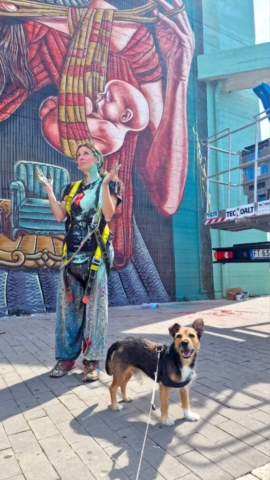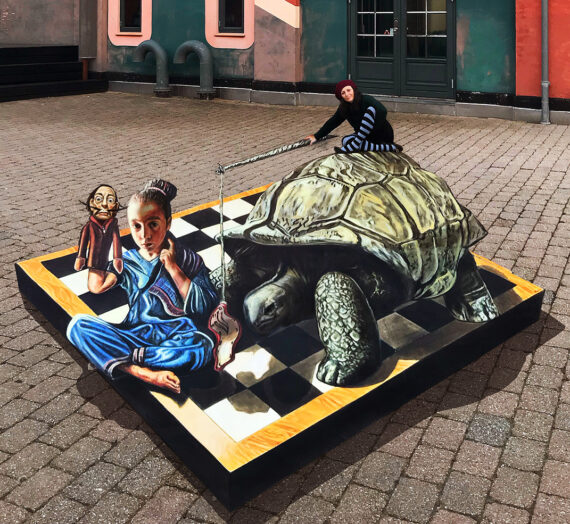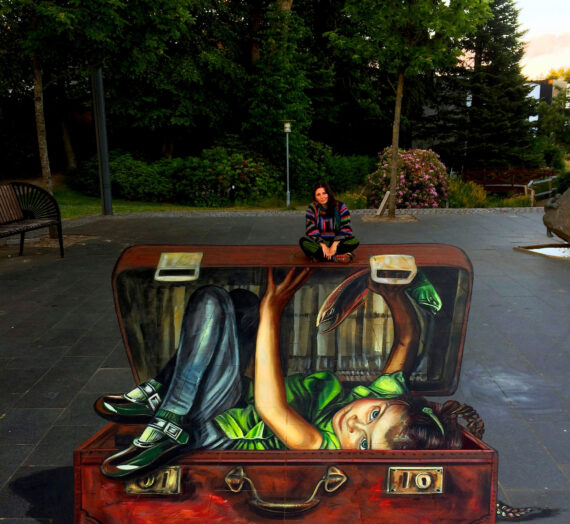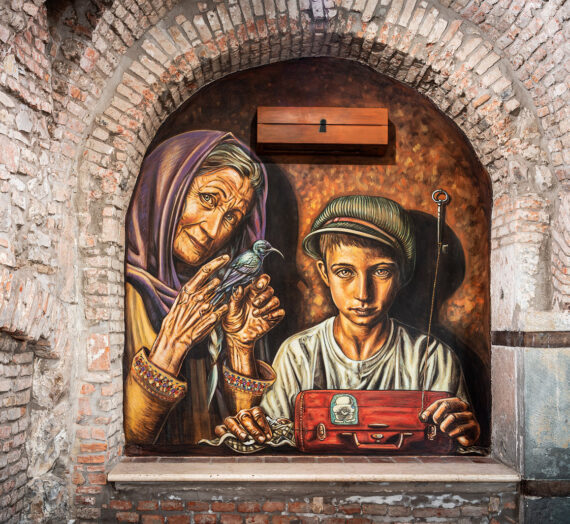“Futuro interiore” è l’opera realizzata a fine agosto a Latina all’interno del festival NIU Nuove identità urbane, curato da Giacomo Marinaro.
Il tema che ho affrontato, non senza qualche difficoltà, è quello della parità di genere e vi ringrazio per i messaggi e le interpretazioni del soggetto che mi avete scritto nel frattempo (sono sempre stimoli per nuove idee).
Questo è un piccolo resoconto del progetto, che si chiude con la poetica del mio intervento, il famoso significato dell’opera, che ogni volta si arricchisce (e si modifica!) durante la gestazione del pezzo.
Grazie per la lettura e la pazienza.
A febbraio 2022 mi contattò Giacomo Marinaro proponendomi di partecipare al bando Lazio Street Art con un progetto che avrebbe previsto a settembre tre interventi di arte urbana a Latina coinvolgendo altri due artisti, Oniro e Attorrep.
Un piccolo museo a cielo aperto su tre pareti sorelle in un quartiere popolare della città, con attività sul territorio e la collaborazione con realtà associative locali come il Centro Donna Lilith, presidio antiviolenza. Il mio pezzo dedicato alla parità di genere, quello di Oniro a tematiche ambientali, quello di Attorrep all’identità territoriale cittadina.
Poi è passato quasi un anno e sembrava più che probabile che saltasse tutto.
La regione aveva stilato i vincitori del bando a gennaio 2023, oltre la data del nostro festival, il comune aveva cambiato referenti dopo che erano state indette nuove elezioni, le pareti delle case popolari non erano più disponibili. Alla fine purtroppo l’idea delle opere affiancate, della galleria a cielo aperto, è miseramente crollata e ci siamo ritrovati su tre muri distanti fra loro e in condizioni ben diverse da quanto previsto.
Nel mio caso una parete in cemento armato con pezzi aggettanti che si staccavano mentre ci dipingevo sopra e la sezione inferiore del muro ricoperta da manifesti pubblicitari che ormai erano un tutt’uno col cemento.
Con l’aiuto della crew di Gulia Urbana – Giacomo, Matteo, Alessandro e Iacopo – ho provato a rimuovere la carta ma con scarsi risultati, ne restavano molti pezzi attaccati e penzolanti. Alla fine ci ho dipinto sopra (cosa poteva essere una superficie effimera per me che avevo lavorato tanto su asfalto?), facendo la quadrettatura pezzo per pezzo col righello perché la bindella non tracciava sui dislivelli.
C’erano 39 gradi e la sera vedere solo dei quadretti mi ha un po’ amareggiata. Chi ben comincia?
Alla fine i ragazzi recuperavano la piattaforma ogni sera e la riportavano al mattino perché l’area – la stazione delle autolinee di via Cervone – era considerata poco sicura e a maggior ragione non sarebbe stato sensato lasciare i materiali nel furgone.
Dopo i primi ostacoli e dopo aver insistito per avere la piattaforma in loco alle sette del mattino (facendomi probabilmente odiare) sono riuscita ad iniziare a tracciare.
Avevo la testa sempre in subbuglio, non ero convinta della mia bozza né di ciò che provavo ad esprimere attraverso di essa. Stavo lì fino alle otto nove di sera e devo dire di aver fatto sempre aspettare tutti per cenare, i ragazzi lì seduti a presidiare e affamati, gli altri artisti come sempre più veloci di me, giunti lì per vedere se fossi pronta. Quindi scendevo, ormai ci vedevo poco, facevo una cronologia mentale delle cose che avrei dovuto fare il giorno successivo. Ero lì ma contemporaneamente non lo ero.
Poi l’opera ha cominciato ad uscire e forse la tensione è un po’ calata, in me e con loro, che in fondo, credo, si erano anche un po’ affezionati e volevano portarmi a mangiare tipico e stare un po’ tranquilli.
Alla fine, l’ultimo pomeriggio, dopo un cambio di piattaforma perché la mia si bloccava, ho fatto una manovra maldestra incastrando il cestello nel braccio e rovesciando di colpo tutti i colori, sul muro (poco, per fortuna), sulla mia persona (completamente), sul cestello, a terra. Ci siamo ricordati del ‘no ma Vera è pulita, non sporca, non serve il tappetino, non serve mascherare completamente la cesta’. Appunto, grasse risate e via.
Quindi fra tentare di ritoccare l’opera, pulire, sistemare i colori, caricare i materiali, sono passate alcune ore e i ragazzi sono ripartiti di corsa verso la Calabria.
Io ho passato ore a tentare di staccare il colore dai capelli, invano, alla fine ho tagliato dei bei ciuffi. Ed era sera, tutto finito, volato, dovevo preparare la valigia per il treno del mattino.
Sono quindi tornata al muro a salutare alcune persone conosciute in settimana, a rivedere ciò che avevo fatto, a fare qualche ripresa con Iacopo.
Tanti commenti, anche di buon cuore, mi avevano fatto capire che il tema della parità di genere non è conosciuto, anzi, c’è molta strada da fare. Rieducare i ragazzi anche, ma rieducare tutti, in fondo.
Ecco la poetica che avevo scritto un anno e mezzo fa. Ho scoperto che il titolo che avevo pensato è lo stesso di un libro che di Michela Murgia, da poco scomparsa. Non conoscevo questo suo libro ma la ascoltavo spesso, con interesse, proprio su queste tematiche così preziose. Grazie Michela.
Le disparità di genere costituiscono uno dei maggiori ostacoli allo sviluppo sostenibile, alla crescita economica e alla lotta contro la povertà. Riflettere su questi temi, sostenere l’autodeterminazione femminile e lottare per l’uguaglianza di diritti a tutti i livelli di partecipazione, porta inevitabilmente ad affrontare questioni drammatiche, come la violenza sulle donne, cancro di tremenda attualità.
Come artista (ma anche come donna) ho tentato un approccio al tema che potesse coniugare la mia poetica con una narrazione iconica scaturita da suggestioni eterogenee. L’opera è onirica e reca una valenza simbolica, proponendo una monumentale personificazione femminile che ricorda alcuni pezzi teratologici che ho dipinto in passato. Una giovane donna con il capo che si muta in un ammasso di tentacoli di piovra fa scivolare fra le dita un elastico che regge un neonato dormiente avvolto in un panneggio. Al centro della composizione il corsetto della ragazza mostra un ambiente straniante che le attraversa il corpo dal petto al ventre, rivelando un palcoscenico spoglio che ospita una poltrona vuota ed alcuni oggetti.
Il titolo allude al tempo verbale del futuro anteriore, che si palesa a livello iconografico come futuro interiore, prefigurazione di ciò che si suppone sarà il destino di lei, in base a come deciderà di agire. Lo stesso tempo verbale è detto anche futuro composto e ciò mi ha fatto pensare ad uno spazio temporale con-posto, con riferimento a quella seduta che attende ognuno come protagonista e giudice del proprio spettacolo, quasi un’etimasia psicologica ineluttabile che dalla sfera del sacro salta al fenomeno della coscienza. Accanto alla poltrona campeggiano una valigia e alcuni libri, simboli di conoscenza e comprensione dell’altro.
Non ho voluto riferire precisamente al mondo del lavoro, della famiglia, delle relazioni, ma implicitamente nell’opera ci sono tutti questi elementi.
Nel bimbo dormiente la cura dei figli (per la maggior parte appaltata alle madri) ma anche l’idea che venendo al mondo si è già fortemente condizionati (in alcuni casi da un ambiente ostile e opportunità difficili da cogliere, da prevaricazione ed ignoranza).
Il capo tentacolare è un duplice rimando simbolico. Da un lato le difficoltà da affrontare, le vessazioni subite, la tirannia cui si è soggiogate. Dall’altro l’adattabilità e il potere del rinnovamento, un vero e proprio rigenerarsi.
Dai tentacoli, nella parte sinistra dell’opera, nascono infatti dei fiori. Legato ad essi, a bilanciare il movimento tentacolare, pende un altro elastico che regge un pesce boccheggiante, ad evocare il rapporto con sé stessi di fronte agli urti del mondo. Forse è proprio in questo pesce che mi identifico.
“Inner Future” is the work created at the end of August in Latina as part of the NIU New Urban Identities festival, curated by Giacomo Marinaro.
The topic that I have addressed, not without some difficulty, is that of gender equality and I thank you for the messages and interpretations of the subject that you have written to me in the meantime (they are always stimuli for new ideas).
This is a small report of the project, which ends with the poetics of my intervention, the famous meaning of the work, which is enriched (and modified!) every time during the gestation of the piece. Thanks for reading and your patience.
In February 2022, Giacomo Marinaro contacted me proposing that I participate in the Lazio Street Art call with a project that would have included three urban art interventions in Latina in September involving two other artists, Oniro and Attorrep.
A small open-air museum on three sister walls in a popular neighborhood of the city, with activities in the area and collaboration with local associations such as the Lilith Women’s Centre, an anti-violence unit.
My piece dedicated to gender equality, Oniro’s to environmental issues, Attorrep’s to the city’s territorial identity.
Then almost a year passed and it seemed more than likely that everything would fall apart. The region had drawn up the winners of the tender in January 2023, beyond the date of our festival, the municipality had changed contact persons after new elections had been called, the walls of the public housing were no longer available.
In the end, unfortunately, the idea of the works placed side by side, of the open-air gallery, collapsed miserably and we found ourselves on three walls distant from each other and in very different conditions than expected.
In my case, a reinforced concrete wall with jutting pieces that came off while I was painting on it and the lower section of the wall covered with advertising posters that were now one with the concrete. With the help of the Gulia Urbana crew – Giacomo, Matteo, Alessandro and Iacopo – I tried to remove the paper but with poor results, many pieces remained attached and dangling.
In the end I painted on it (what could an ephemeral surface be for me who had worked so much on asphalt?), making the squares piece by piece with the ruler because the rib didn’t trace on the unevenness. It was 39 degrees and, in the evening, just seeing some little pictures made me a little saddened.
Who’s off to a good start?
In the end the boys recovered the platform every evening and brought it back in the morning because the area – the bus station in Via Cervone – was considered unsafe and even more so it would not have made sense to leave the materials in the van. After the first obstacles and after insisting on having the platform on site at seven in the morning (probably making me hate myself) I managed to start tracing.
My head was always in turmoil, I wasn’t convinced of my draft nor of what I was trying to express through it.
I was there until eight or nine in the evening and I must say that I always kept everyone waiting for dinner, the boys sitting there watching over and hungry, the other artists always faster than me, arriving there to see if I was ready. So, I went down, I couldn’t see much anymore, I made a mental chronology of the things I had to do the next day. I was there but at the same time I wasn’t.
Then the work began to come out and perhaps the tension dropped a little, in me and with them, who deep down, I think, had also become a little fond of it and wanted to take me out for typical food and be a bit calm.
In the end, on the last afternoon, after a change of platform because mine was blocked, I made a clumsy maneuver by jamming the basket in the arm and suddenly spilling all the colors, on the wall (not much, fortunately), on my person (completely), on the basket, on the ground.
We remembered the sentence: ‘Vera is clean, she doesn’t get dirty, she doesn’t need the mat, she doesn’t need to completely mask the basket’. Exactly, big laughs.
Well, between trying to retouch the work, cleaning, arranging the colours, loading the materials, a few hours passed and the boys set off again in a hurry towards Calabria.
I spent hours trying to remove the color from my hair, in vain, in the end I cut off some nice tufts.
And it was evening, everything was over, flown by, I had to pack my suitcase for the morning train. I then went back to the wall to say hello to some people I had met during the week, to review what I had done, to take some shots with Iacopo.
Many comments, even kind-hearted ones, had made me understand that the topic of gender equality is not known, indeed, there is a long way to go.
Re-educate kids too, but ultimately re-educate everyone.
Here is the poetry I wrote a year and a half ago.I discovered that the title I had thought of is the same as a book by Michela Murgia, who recently passed away.I didn’t know this book by her but I often listened to her, with interest, on these very precious topics.Thanks Michela.
Gender disparities constitute one of the major obstacles to sustainable development, economic growth and the fight against poverty.
Reflecting on these issues, supporting female self-determination and fighting for equal rights at all levels of participation inevitably leads to addressing dramatic issues, such as violence against women, a cancer of tremendous relevance.
As an artist (but also as a woman) I attempted an approach to the theme that could combine my poetics with an iconic narrative arising from heterogeneous suggestions. The work is dreamlike and carries a symbolic value, proposing a monumental female personification that recalls some teratological pieces that I have painted in the past.
A young woman whose head turns into a mass of octopus tentacles slides between her fingers an elastic band holding a sleeping newborn baby wrapped in drapery. At the center of the composition, the girl’s corset shows an alienating environment that crosses her body from chest to belly, revealing a bare stage that houses an empty armchair and some objects.
The title alludes to the verb tense of the future perfect, which is revealed on an iconographic level as an internal future, a prefiguration of what is supposed to be her destiny, based on how she decides to act.
The same verbal tense is also called the compound future and this made me think of a temporal space with place, with reference to that session that awaits everyone as protagonist and judge of their own show, almost an inevitable psychological ethymasia that from the sphere of the sacred jumps to the phenomenon of consciousness.
Next to the armchair there is a suitcase and some books, symbols of knowledge and understanding of others. I didn’t want to refer specifically to the world of work, family, relationships, but implicitly there are all these elements in the work. In the sleeping child, the care of the children (mostly outsourced to the mothers) but also the idea that by coming into the world one is already strongly conditioned (in some cases by a hostile environment and opportunities that are difficult to seize, by abuse and ignorance).
The tentacled head is a double symbolic reference. On the one hand, the difficulties to be faced, the harassment suffered, the tyranny to which one is subjected. On the other, adaptability and the power of renewal, a true regeneration. In fact, flowers emerge from the tentacles on the left side of the work. Tied to them, to balance the tentacular movement, hangs another elastic band holding a gasping fish, to evoke the relationship with oneself in the face of the shocks of the world. Perhaps it is precisely this fish that I identify with.
